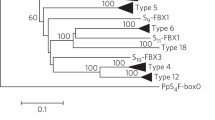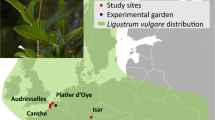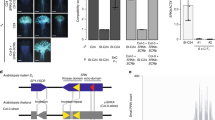Summary
In self-incompatible angiosperms correlations have been discovered between the genetic systems of compatibility control, floral morphology, pollen cytology, and site of pollen inhibition. The present paper critically reviews these relationships and their exceptions with particular reference to the time and site of theS-gene action. A hypothesis explaining these relationships and some of the exceptions has been proposed earlier. The major factor affecting these relationships is believed to be time of theS-gene action — late- or post-meiotic (not earlier than telophase I) in the gametophytic system and early (homomorphic) — or premeiotic (heteromorphic) in the sporophytic system. Recent work of Heslop-Harrison and his colleagues has provided additional evidence about the suggested timing of theS-gene action in the gametophytic species. In the sporophytic species, however, Heslop-Harrison suggests that theS-gene action occurs in the tapetum and not in the meiocytes. In the present discussion it is argued that tapetal action of certain elements of theS-gene complex is possible, but only in the heteromorphic species. It is suggested that major exceptions are by-products of secondary evolution of incompatibility after the primary incompatibility had been disturbed, or had broken down.
Similar content being viewed by others
References
Arasu, N. T., 1968. Self-incompatibility in angiosperms: A review. Genetica 39: 1–24.
Baker, H. G., 1966. The evolution, functioning, and breakdown of heteromorphic incompatibility systems. I. ThePlumbaginaceae. Evolution 20: 349–368.
Bateman, A. J., 1954. The diversity of incompatibility systems in flowering plants. Proc. VIII Int. Bot. Congr., Paris, Sect. 10: 138–145.
Bateman, A. J., 1956. Cryptic self-incompatibility in the wallflower:Cheiranthus cheiri L. Heredity 10: 257–261.
Brewbaker, J. L., 1957. Pollen cytology and self-incompatibility systems in plants. J. Hered. 48: 271–277.
Brewbaker, J. L. &Natrajan, A. T., 1960. Centric fragments and pollen-part mutation of incompatibility alleles inPetunia. Genetics 45: 699–704.
Brewbaker, J. L. &Shapiro, N., 1959. Homozygosity andS gene mutation. Nature 183: 1209–1210.
Bubar, J. S., 1959. Differences between self-incompatibility and self-sterility. Nature 183: 411–412.
Cleland, R. E., 1950. Studies inOenothera cytogenetics and phylogeny. Indiana University Sci. Ser. 16: 1–348.
Cope, F. W., 1958. Incompatibility inTheobroma cacao. Nature 181: 279.
Crowe, L. K., 1954. Incompatibility inCosmos bipinnatus. Heredity 8: 1–11.
Crowe, L. K., 1955. The evolution of incompatibility in species ofOenothera. Heredity 9: 293–322.
Giles, W. F., 1949. The morphological aspects of self-sterility inLotus corniculatus. Ph. D. Thesis, University of Missouri, Columbia.
Hecht, A., 1964. Partial inactivation of an incompatibility substance in the stigmas and styles ofOenothera. In:H. F. Linskens (Ed.) Pollen physiology and fertilization. North-Holland, Amsterdam, p. 237–243.
Heslop-Harrison, J., 1968a. Ribosome sites andS-gene action. Nature 218: 90–91.
Heslop-Harrison, J., 1968b. Tapetal origin of pollen-coat substances inLilium. New Phytol. 67: 779–786.
Kroh, M., 1964. An electron microscopic study of the behavior ofCruciferae pollen after pollination. In:H. F. Linskens (Ed.), Pollen physiology and fertilization. North-Holland Publ. Co. Amsterdam, p. 221–224.
Lewis, D., 1949. Structure of the incompatibility gene. II. Induced mutation rate. Heredity 3: 339–355
Lewis, D., 1954. Comparative incompatibility in angiosperms and fungi. Adv. Gent. 6: 235–285.
Lewis, D., 1956. Incompatibility and plant breeding. Brookhaven Symp. Biol. 9: 89–100.
Lewis, D., 1961. Chromosome fragments and mutation of the incompatibility gene. Nature 190: 990–991.
Lewis, D. &Crowe, L. K., 1958. Unilateral interspecific incompatibility in flowering plants. Heredity 12: 233–256.
Linskens, H. F. &Heinen, W., 1962. Cutinase-Nachweizen Pollen. Z.Bot. 50: 338–347.
Lundquist, A., 1964. The genetics of incompatibility. In.S. J. Geerts (Ed.), Genetics Today. Pergamon, London, p. 637–647.
Mackenzie, A., Heslop-Harrison, J. &Dickinson, H. G., 1967. Elimination of ribosomes during meiotic prophase. Nature, 215: 997–999.
Makinen, Y. L. A. &Lewis, D., 1962. Immunological analysis of incompatibility (S) proteins and of crossreacting material in a self-compatible mutant ofOenothera organensis. Genet. Res. 3: 352–363.
Mather, K., 1943. Specific differences inPetunia. I. Incompatibility. J. Genet. 45: 215–235.
Mather, K. &De Winton, D., 1941. Adaptation and counteradaptation of the breeding system inPrimula. Ann. Bot. 5: 297–311.
Pandey, K. K., 1956a. Mutation of self-incompatibility alleles inTrifolium pratense andT. repens. Genetics 41: 327–343.
Pandey, K. K., 1956b. Incompatibility in autotetraploidTrifolium pratense. Genetics 41: 353–366.
Pandey, K. K., 1957. Genetics of self-incompatibility inPhysalis ixocarpa Brot. A new system. Am. J. Bot. 44: 879–887.
Pandey, K. K., 1959. Mutations of the self-incompatibility gene (S) and pseudocompatibility in angiosperms. Lloydia 22: 222–234.
Pandey, K. K., 1960. Evolution of gametophytic and sporophytic systems of self-incompatibility in angiosperms. Evolution 14: 98–115.
Pandey, K. K., 1965. Centric chromosome fragments and pollen-part mutation of the incompatibility gene inNicotiana alata. Nature 206: 792–795.
Pandey, K. K., 1967. Elements of theS-gene complex. II. Mutation and complementation at theS I locus inNicotiana alata. Heredity 22: 255–284.
Pandey, K. K., 1968. Compatibility relationships in flowering plants: Role of theS-gene complex. Am. Nat. 102: 475–489.
Pandey, K. K., 1969. Elements of theS-gene complex. V. Interspecific cross-compatibility relationships and theory of the evolution of theS complex. Genetica 40: 447–474.
Panella, A. &Lorenzetti, F., 1966. Selfing and selection in alfalfa breeding programmes. Euphytica 15: 248–257.
Rowlands, D. G., 1958. The nature of the breeding system in the field bean (V. faba L.) and its relationship to breeding for yield. Heredity 12: 113–126.
Schürhoff, P. N., 1926. Die Zytologie der Blutenpflanzen. Ferdinand Ente, Stuttgart.
Steiner, E., 1961. Incompatibility in the complex-heterozygotes ofOenothera. Genetics 46: 301–315.
Whitehead, W. L. &Davis, R. L., 1954. Self- and crosscompatibility in alfalfa (Medicago sativa). Agron. J. 46: 452–456.
Whitehouse, H. L. K., 1950. Multiple allelomorph incompatibility of pollen and style in the evolution of angiosperms. Ann. Bot. 14: 199–216.
Author information
Authors and Affiliations
Rights and permissions
About this article
Cite this article
Pandey, K.K. Time and site of theS-gene action, breeding systems and relationships in incompatibility. Euphytica 19, 364–372 (1970). https://doi.org/10.1007/BF01904215
Received:
Issue Date:
DOI: https://doi.org/10.1007/BF01904215




